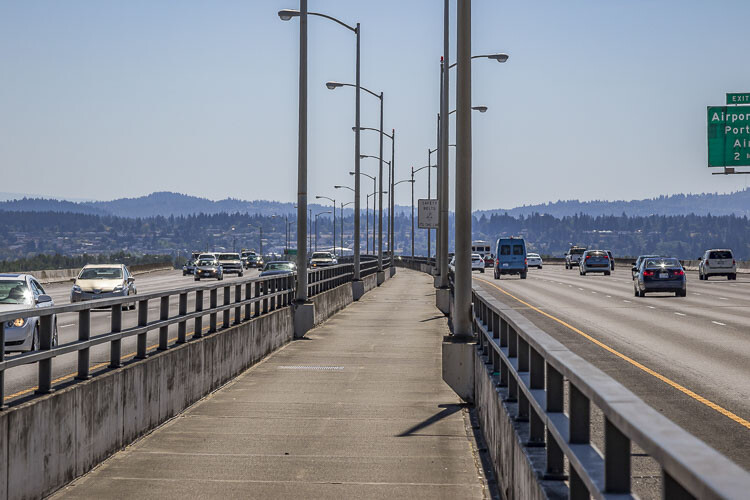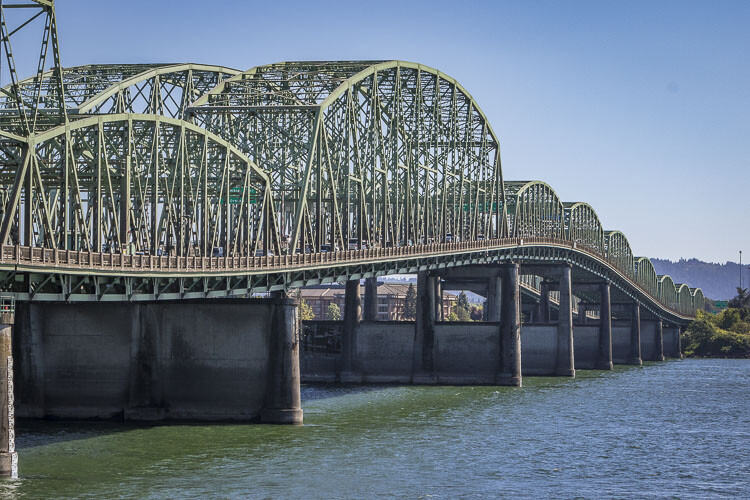
Editor Ken Vance won’t waive the white flag when it comes to the battle over what is in the best interests of Clark County residents when it comes to replacing the I-5 Bridge
Ken Vance, editor
Clark County Today
A couple of weeks ago in our weekly poll question, Clark County Today asked readers this question: Who should pay for the maintenance and operations of the proposed light rail extension into Vancouver? Of the two options offered, more than 85 percent of those who responded said Oregon’s TriMet should pay the estimated $21.6 each year instead of Vancouver’s C-TRAN.

While I agree with the majority of those who voted in the poll, I have regrets about the poll itself. Without going down a rabbit hole that is a “me problem’’ and not a “you problem,’’ there are constraints to the amount of words and potential responses I can use when crafting the weekly poll question. While TriMet seems to be the obvious answer (under the parameters offered) for those of us residing in Clark County, there is one answer that would have been more appropriate in my opinion – neither.
Neither is the more appropriate answer because all evidence has always indicated that Southwest Washington residents don’t want an extension of TriMet’s light rail into Clark County. I realize the last time Clark County residents were asked to voice their opinion on light rail was 10 years ago, but at that time voters overwhelmingly expressed their opposition. In fact, every precinct in Clark County opposed light rail, with the exception of a small area in downtown Vancouver. I wish voters were being asked the question once again in the 2023 November general election. I’m confident the response would be virtually the same.
Let’s not forget that in 2019, Portland metro area voters rejected the Southwest Corridor Light Rail project. That was $2.9 billion of an expected $7 billion metro area transportation package. So the no votes come from both sides of the Columbia River.
We can’t forfeit these battles
In a legislative town hall held earlier this year by 18th District legislators, Sen. Ann Rivers appeared to wave the white flag of surrender to the I-5 bridge replacement project and the Locally Preferred Alternative (LPA) offered by the Interstate Bridge Replacement Program (IBR).
“They have the votes,’’ Sen. Rivers told those in attendance.
I’m not sure who Sen. Rivers was referring to when she said “they’’ or even what votes she was referring to. You see, the only meaningful “votes’’ that have taken place since the governors of Washington and Oregon restarted this project in 2019 were the votes of the legislatures in each state to provide their share of the proposed project’s estimated cost, which is now as high as $7.5 billion.
The members of the Washington State Legislature have approved $1.1 billion in funding as part of the “Move Ahead Washington’’ and “Connecting Washington” transportation packages. On the last day of their 2023 legislative session, Oregon lawmakers allocated $250 million to fund the IBR. So, Washington lawmakers have approved the funding for their portion while Oregon lawmakers have only approved a fraction of their commitment with a promise future legislatures will pay for the rest.
As I said, residents of each state have not been asked to vote on the funding for the project, or even elements of the project and no future votes are expected. The 16 members of the Bi-state Bridge Committee were recently updated on the status of the I-5 bridge replacement but they’ve never been asked to vote on any elements of the project and no votes are scheduled in the future.
So, the governors of these two states have assigned the IBR the task of building a new bridge to replace the existing I-5 Bridge. The lawmakers of each state have collectively approved funding plans for their shares of the project. The IBR team, which hopes the project cost will come in closer to $6 billion than $7.5 billion, hopes to get a sizable contribution in the range of $1.5 billion to $2.5 billion from the federal government and then tolls will contribute about $1.2 billion. (More details on the proposed funding package is available here.)
Reason for hope for a better project
I have said all along, I am not against replacing the I-5 Bridge. I would prefer that our elected officials and community leaders focus on a third or even a fourth crossing over the Columbia River first. After all, I had just graduated from high school in 1982 when the I-205 Glenn Jackson Bridge opened and transportation experts identified the need even then for a third and fourth crossing over the Columbia River.

More realistically, at this point, is the need for a better project to replace the I-5 Bridge. First and foremost, Washington residents don’t want or need light rail, which could be replaced with C-TRAN’s Bus Rapid Transit. Federal transit officials are big fans of the use of BRT over light rail as we learned recently. That would save as much as $2 billion on the overall cost of the project, not to mention that $21.6 million in maintenance and operations each year thereafter.
I realize that we don’t get Oregon lawmakers and transportation officials to the table without light rail, well I am happy to call their bluff. They have 75,000 Southwest Washington residents who commute to Oregon to work and pay income taxes in that state so they have a clear vested interest. They are an extremely poor partner in this project. They have a handful of their own road projects in that state that aren’t paid for and there is no reason to pad the costs of the I-5 bridge replacement to help them out on those other projects.
In addition to that, the IBR’s transit ridership projections are unrealistic. Presently there are less than 1,000 “boardings” of transit across the Columbia River (I-5 and I-205 bridges). The IBR projects by 2045 there will be 26,000 to 33,000 daily boarding on the I-5 corridor alone. There is no evidence transit ridership will increase 30 to 50 fold in the next two decades, let alone during the life of a replacement bridge.
Perhaps the biggest vulnerability in the IBR team’s LPA, and the greatest hope for those of us asking for a more appropriate project, is the fact that the U.S. Coast Guard has rejected their request to build a “bridge too low’’ with only 116 feet of clearance for marine traffic. Coast Guard officials are appropriately demanding a bridge that provides at least the current 178 feet of clearance. It is my hope the U.S. Coast Guard will hold firm on its demand. If it does, it’s unlikely that any bridge design that meets that height requirement can accommodate light rail.

Another glimmer of hope comes from the fact that the many questions currently looming over the project (bridge height, light rail, tolling, Oregon’s funding, etc.) will keep federal officials from approving the needed funding. In addition to those questions, let’s not forget that the current proposal doesn’t reduce traffic congestion. When U.S. Transportation Secretary Pete Buttigieg visited Washougal earlier this summer he spoke about people’s most valuable commodity being time. Even the IBR team members admit that the current project doesn’t reduce traffic congestion or save drivers time.
So, let’s not be like Sen. Rivers. Don’t give up. Fight the good fight. And, just as importantly, don’t support elected officials who won’t do the same.
Also read:
- Busy pavement season ahead on Vancouver streetsThe city of Vancouver is set to repave and preserve 76 lane miles across 20 neighborhoods in summer 2025, with ADA upgrades and community notices throughout.
- State representative: Expect sticker shock when Interstate Bridge project officials reveal price, tolling plansAt a town hall in Battle Ground, Rep. John Ley warned of major cost increases and tolling burdens tied to the Interstate Bridge replacement project.
- Opinion: Washington state lawmakers increase the cost of driving – againBob Pishue of Mountain States Policy Center argues that new vehicle and fuel taxes in Washington will raise driving costs while diverting funds away from roads.
- Overnight full closure of I-5 near Woodland for bridge inspection, May 6WSDOT will fully close southbound I-5 near Woodland overnight on Tuesday, May 6 for a bridge inspection using a chain drag test.
- Opinion: Do we still need TriMet?John A. Charles Jr. of the Cascade Policy Institute argues that TriMet should halt expansion plans and prepare for major service reductions in response to falling ridership and rising costs.










Rivers’ hypocrisy is astounding. Willamette Week named her “bridge killer” back when she was a Republican and the irony of all of this is that absolutely nothing has changed from when she led the charge on killing the CRC scam last time until today.
Except Rivers’ job.
Every single reason to get rid of this light rail scam (And light rail is the ONLY reason they want to do this… Rivers said so herself) is still present.
The difference is, as Rivers told Lefty Lou Brancaccio, she had “reframed her thinking” and “excluded the congestion piece of it,” which, of course, is the only reason to do ANYTHING with the I-5 Bridge.
“Who cares if it doesn’t reduce congestion? We need a new bridge.” You can bet your bippy her commuting constituents, who, unlike Rivers or any other bridge scammer, are going to have to pay for the privilege of sitting in the traffic jam they’ll continue to face every day even after this light rail project is completed, care. Ever-increasing tolls will FORCE them to care.
Rivers, of course, led the charge to put together the legislative advisory idiots, as while she may be poor-mouthing the lack of votes to end this scam NOW, her efforts are what restarted this insanity in the first place.
It wasn’t all that long ago the puppets on the so-called advisory committee expressed disappointment when they allegedly found out what even *I KNEW* from the start: that they were merely window dressing and what they said, wanted or thought was meaningless.
Believe me: if *I* knew it, THEY knew it and their whining was only to try and get political cover for their complete betrayal of their constituents in Clark County. And it does give me pause:
Remember when Steve Stuart sold us out on the TriMet $5 million penalty if we didn’t let them exercise eminent domain in Clark County and magically wound up getting the City Manager gig for Ridgefield?
Remember when Ann Rivers rejuvenated the insanity of the CRC Scam and wound up getting the so-called “Community Development Director” for Longview and about 10 minutes later wound up “Assistant City Manager?”
Those two gigs were OBVIOUSLY a coincidence… particularly when you consider what preceded it.
Right?
https://clarkcountypolitics.blogspot.com/2019/01/looks-like-we-finally-get-reason-rivers.html
Seriously. Can we pave over the entire river and be done with it?
Nearly a decade or more worth of ridicule, smears, lies and opposition directed at Ann Rivers, opposing her reelection, trashing her every which way imaginable by Republicans, some acting more like spurned Jr. High School boys and y’all wonder why she doesn’t walk lock step with the extremists that have taken over the CCGOP?
And y’all wonder why you’re losing supporters??
Several of us share in Rivers views and it isn’t giving up, it is fed up with the belligerence, denigrating lies an smears directed at those deemed “unfaithful” by the extremists.
When you wonder why you no longer receive support, take a long look in your mirrors.
Challenge to all the Third Bridgers: Name one landing spot in Oregon for a third bridge that has been accepted, approved and promoted by officials in Oregon. (Hint: There isn’t one.) But because the Third Bridgers can’t recognize that Oregon is an equal (if not greater) stakeholder in river-crossing matters, they’ll continue clinging to their pipe dream. (Disclosure: Much to my chagrin, I no longer reside in Clark County.)
Here we go again. Bridge with rail transit = politician and contractor money scam.
Trolly cars — they were ripped out after WWII because they were inflexible and inefficient. They are still inflexible and inefficient (and dreadfully expensive with ongoing maintenance and labor costs exceeding bus rapid transit). Big bucks to favored contractors and unions, though.
Portland, like the SF Bay area, has a significant and vocal “anti-car” contingent. Rather than cope with traffic (caused by economic activity and population growth) they’d rather pretend that trolly cars will replace automobiles and that people will willingly live in tiny high rise condos built above shops in a crowded city. Unfortunately, these folks are “in charge” in Olympia and in Oregon.
It would be better to spend up to several hundreds of millions to refurbish the current I5 Bridge that to waste Billion$ on a new bridge that will lack capacity, and lack flexibility for the future.
Thank you, Ken Vance! Your points about the need for a new project instead of what is being proposed, are nice and clear.
I share your vision about the need for another crossing FIRST. What a mess things will be when trying to get across the river otherwise. It is often a mess now, mainly during peak travel times, even with the current two operational bridges, I-5 and I-205. No matter what we may be told, experience tells me that when a new bridge is being constructed where an old one exists, there will be many delays/slowdowns due to the construction/destruction work, and at times it is hard to imagine there won’t be closures. Very concerning too when considering emergency response times may be severely impacted. IBRP has stated that their new bridge would take about 7 or more years to complete. That’s a long time…
I really can understand people wanting to reduce the number of vehicles traveling on the roads, and/or alter the times that they travel, and I agree, but so many travelers simply need to travel where and when they do in order to support themselves or their families. We can’t all work from home, or change the times. There has been a lot of talk about mass transport, but it simply doesn’t work for most, (though with planning, carpooling fortunately can sometimes). The same goes for the need for trucks on the roads, since it is obvious that our civilization currently is highly dependent on the supply chain in order to survive.
Until we take to flying cars/skateboards or something, looks like we are still going to need enough bridges either across OR UNDER rivers. I would vote for modest ones with smaller footprints though, so that we don’t seriously harm communities like Hayden Island, (over 3,000 residents), and definitely NOT build superhighway bridges that cost 7.5 billion dollars or more!
I have a challenge for anyone interested in trying it for themselves. Do a simple tabletop exercise, kind of like the military or emergency responders might do when working out a good plan. Maybe draw or print out a map of the Vancouver/Portland area. If you can use clever computer software instead to do it, that’s great! I wish I could! Do your own simple traffic study based on your own experiences! See if another modest bridge, or two, makes more sense to you than launching into first destroying an existing one and putting another one in its place that will take years to complete. I believe it is a mistake to continue to have so many ‘eggs’, I-5 and I-205, in just the two baskets. After all, if the Willamette River has a bunch of bridges to serve the need, surely another bridge placed in a suitable position either over or under the Columbia River is OK?
Hoping for the very best outcome possible for people on both sides of the river. Thanks for reading.
Fares on MAX only pay 17% of operating costs! And the IBR wants to extend it into Vancouver? Just burn our tax dollars…..